西安电子科技大学:《博弈论》课程教学资源(PPT课件)Lecture 3 Dynamic games of complete information
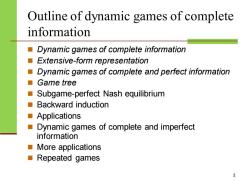
Outline of dynamic games of complete information Dynamic games of complete information ■ Extensive-form representation Dynamic games of complete and perfect information ■Game tree Subgame-perfect Nash equilibrium ■Backward induction ■Applications Dynamic games of complete and imperfect information ■More applications ■Repeated games
Outline of dynamic games of complete information ◼ Dynamic games of complete information ◼ Extensive-form representation ◼ Dynamic games of complete and perfect information ◼ Game tree ◼ Subgame-perfect Nash equilibrium ◼ Backward induction ◼ Applications ◼ Dynamic games of complete and imperfect information ◼ More applications ◼ Repeated games 2
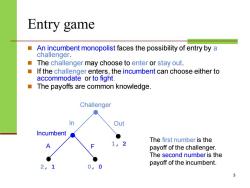
Entry game An incumbent monopolist faces the possibility of entry by a challenger. The challenger may choose to enter or stay out. If the challenger enters,the incumbent can choose either to accommodate or to fight. The payoffs are common knowledge. Challenger In Out Incumbent The first number is the 1 2 payoff of the challenger. The second number is the 2, 0,0 payoff of the incumbent. 3
Entry game ◼ An incumbent monopolist faces the possibility of entry by a challenger. ◼ The challenger may choose to enter or stay out. ◼ If the challenger enters, the incumbent can choose either to accommodate or to fight. ◼ The payoffs are common knowledge. 3 Challenger In Out Incumbent A F 1, 2 2, 1 0, 0 The first number is the payoff of the challenger. The second number is the payoff of the incumbent
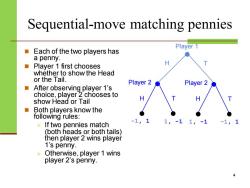
Sequential-move matching pennies Player 1 ■ Each of the two players has a penny. Player 1 first chooses whether to show the Head or the Tail. Player 2 Playe After observing player 1's choice,player 2 chooses to show Head or Tail Both players know the following rules: If two pennies match (both heads or both tails) then player 2 wins player 1's penny. Otherwise,player 1 wins player 2's penny
Sequential-move matching pennies ◼ Each of the two players has a penny. ◼ Player 1 first chooses whether to show the Head or the Tail. ◼ After observing player 1’s choice, player 2 chooses to show Head or Tail ◼ Both players know the following rules: ➢ If two pennies match (both heads or both tails) then player 2 wins player 1’s penny. ➢ Otherwise, player 1 wins player 2’s penny. 4 Player 1 Player 2 H T -1, 1 1, -1 H T Player 2 H T 1, -1 -1, 1
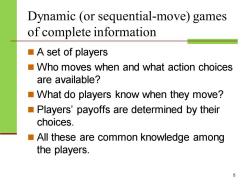
Dynamic (or sequential-move)games of complete information ■A set of players Who moves when and what action choices are available? What do players know when they move? Players'payoffs are determined by their choices. All these are common knowledge among the players
Dynamic (or sequential-move) games of complete information ◼ A set of players ◼ Who moves when and what action choices are available? ◼ What do players know when they move? ◼ Players’ payoffs are determined by their choices. ◼ All these are common knowledge among the players. 5
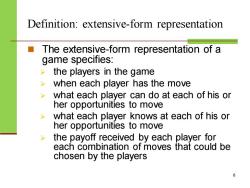
Definition:extensive-form representation The extensive-form representation of a game specifies: the players in the game when each player has the move > what each player can do at each of his or her opportunities to move what each player knows at each of his or her opportunities to move the payoff received by each player for each combination of moves that could be chosen by the players 6
Definition: extensive-form representation ◼ The extensive-form representation of a game specifies: ➢ the players in the game ➢ when each player has the move ➢ what each player can do at each of his or her opportunities to move ➢ what each player knows at each of his or her opportunities to move ➢ the payoff received by each player for each combination of moves that could be chosen by the players 6
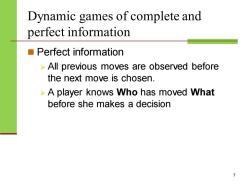
Dynamic games of complete and perfect information ■Perfect information -All previous moves are observed before the next move is chosen. >A player knows Who has moved What before she makes a decision
Dynamic games of complete and perfect information ◼ Perfect information ➢ All previous moves are observed before the next move is chosen. ➢ A player knows Who has moved What before she makes a decision 7
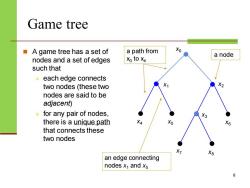
Game tree ■ A game tree has a set of a path from Xo a node nodes and a set of edges Xo to x4 such that > each edge connects two nodes (these two X2 nodes are said to be adjacent) for any pair of nodes, X3 there is a unique path X6 that connects these two nodes X8 an edge connecting nodes x1 and x5
Game tree ◼ A game tree has a set of nodes and a set of edges such that ➢ each edge connects two nodes (these two nodes are said to be adjacent) ➢ for any pair of nodes, there is a unique path that connects these two nodes 8 x0 x1 x2 x3 x4 x5 x6 x7 x8 a node an edge connecting nodes x1 and x5 a path from x0 to x4
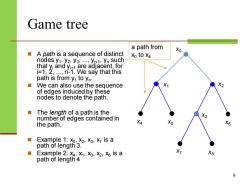
Game tree a path from A path is a sequence of distinct Xo Xo to x4 nodes y1,y2,y3,...,yn-1,yn such that yi and yit1 are adjacent,for i=1,2,...n-1.We say that this path is from y1 to yn. We can also use the sequence X2 of edges induced by these nodes to denote the path. The length of a path is the number of edges contained in the path. X6 Example 1:Xo,X2,X3,X7 is a path of length 3. Example 2:X4,X1,Xo,X2,X6 is a X7 path of length 4
Game tree ◼ A path is a sequence of distinct nodes y1 , y2 , y3 , ..., yn-1 , yn such that yi and yi+1 are adjacent, for i=1, 2, ..., n-1. We say that this path is from y1 to yn . ◼ We can also use the sequence of edges induced by these nodes to denote the path. ◼ The length of a path is the number of edges contained in the path. ◼ Example 1: x0 , x2 , x3 , x7 is a path of length 3. ◼ Example 2: x4 , x1 , x0 , x2 , x6 is a path of length 4 9 x0 x1 x2 x3 x4 x5 x6 x7 x8 a path from x0 to x4
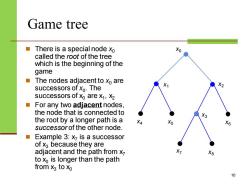
Game tree There is a special node xo Xo called the root of the tree which is the beginning of the game The nodes adjacent to xo are successors of xo.The successors of xo are x1,X2 For any two adjacent nodes, the node that is connected to the root by a longer path is a X4 X6 successor of the other node. Example 3:x is a successor of x3 because they are adjacent and the path from x X8 to xo is longer than the path from x3 to Xo 6
Game tree ◼ There is a special node x0 called the root of the tree which is the beginning of the game ◼ The nodes adjacent to x0 are successors of x0 . The successors of x0 are x 1 , x2 ◼ For any two adjacent nodes, the node that is connected to the root by a longer path is a successor of the other node. ◼ Example 3: x7 is a successor of x3 because they are adjacent and the path from x7 to x0 is longer than the path from x3 to x0 10 x0 x 1 x2 x3 x4 x5 x6 x7 x8
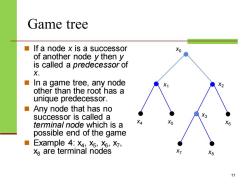
Game tree If a node x is a successor Xo of another node y then y is called a predecessor of X. In a game tree,any node X2 other than the root has a unique predecessor. ■Any node that has no successor is called a terminal node which is a X4 X5 X6 possible end of the game ■ Example 4:X4:X5,X6,X7, Xs are terminal nodes X7 X8 11
Game tree ◼ If a node x is a successor of another node y then y is called a predecessor of x. ◼ In a game tree, any node other than the root has a unique predecessor. ◼ Any node that has no successor is called a terminal node which is a possible end of the game ◼ Example 4: x4 , x5 , x6 , x7 , x8 are terminal nodes 11 x0 x1 x2 x3 x4 x5 x6 x7 x8
按次数下载不扣除下载券;
注册用户24小时内重复下载只扣除一次;
顺序:VIP每日次数-->可用次数-->下载券;
- 西安电子科技大学:《博弈论》课程教学资源(PPT课件)Lecture 2 Mixed strategy game(任课教师:栾浩).ppt
- 西安电子科技大学:《博弈论》课程教学资源(PPT课件)Lecture 1 GAME THEORY - Static complete information pure strategy game.ppt
- 《概率论与数理统计》课程教学资源(参考教材)概率论教材 Probability and Statistics《A FIRST COURSE IN PROBABILITY》英文电子版(Eighth Edition,Sheldon Ross).pdf
- 同济大学:《概率论与数理统计》课程教学资源(讲稿)Chapter 9 Sampling Distributions.pdf
- 同济大学:《概率论与数理统计》课程教学资源(讲稿)Chapter 10 Point Estimation.pdf
- 同济大学:《概率论与数理统计》课程教学资源(讲稿)Chapter 8 Limit Theorems.pdf
- 同济大学:《概率论与数理统计》课程教学资源(讲稿)Chapter 6 Jointly Distributed Random Variables.pdf
- 同济大学:《概率论与数理统计》课程教学资源(讲稿)Chapter 5 Continuous Random Variables.pdf
- 同济大学:《概率论与数理统计》课程教学资源(讲稿)Chapter 4 Mathematics.pdf
- 同济大学:《概率论与数理统计》课程教学资源(讲稿)Chapter 3 Conditional Probability and Independence.pdf
- 同济大学:《概率论与数理统计》课程教学资源(讲稿)Chapter 2 Axioms of Probability(负责人:花虹).pdf
- 同济大学:《复变函数和积分变换》课程教学资源(PPT课件讲稿)习题选讲4(积分的计算、共形映照).pptx
- 同济大学:《复变函数和积分变换》课程教学资源(PPT课件讲稿)习题选讲3(级数及其应用、奇点与留数).pptx
- 同济大学:《复变函数和积分变换》课程教学资源(PPT课件讲稿)习题选讲2(复变函数的两种形式、计算解析函数的级数).pptx
- 同济大学:《复变函数和积分变换》课程教学资源(PPT课件讲稿)习题选讲1(复数的四则运算、复数的幂与根).pptx
- 同济大学:《复变函数和积分变换》课程教学资源(PPT课件讲稿)5-2-分式线性变换.pptx
- 同济大学:《复变函数和积分变换》课程教学资源(PPT课件讲稿)5-1-映射的共形性.pptx
- 同济大学:《复变函数和积分变换》课程教学资源(PPT课件讲稿)4-3-利用积分变换求解微分方程.pptx
- 同济大学:《复变函数和积分变换》课程教学资源(PPT课件讲稿)4-2-Laplace变换.pptx
- 同济大学:《复变函数和积分变换》课程教学资源(PPT课件讲稿)4-1-Fourier变换.pptx
- 西安电子科技大学:《博弈论》课程教学资源(PPT课件)Lecture 4 Static game of incomplete information.ppt
- 西安电子科技大学:《博弈论》课程教学资源(PPT课件)Lecture 5 Dynamic game with Incomplete Information.ppt
- 同济大学:《常微分方程》课程教学资源(讲义)First-order differential equations.pdf
- 同济大学:《常微分方程》课程教学资源(讲义)微分方程基本概念及几类可求解析解的方程.pdf
- 同济大学:《常微分方程》课程教学资源(讲义)高阶线性微分方程.pdf
- 同济大学:《常微分方程》课程教学资源(讲义)线性微分方程组 Linear Systems of Differential Equations(负责人:尚培培).pdf
- 同济大学:《常微分方程》课程教学资源(讲义)非线性微分方程及现象 Nonlinear Systems and Phenomena.pdf
- 同济大学:《运筹学》课程教学资源(试卷习题)运筹学试卷1.doc
- 同济大学:《运筹学》课程教学资源(试卷习题)运筹学试卷2.doc
- 同济大学:《运筹学》课程教学资源(课件讲稿)引言 Operations Research(负责人:陈雄达).pdf
- 同济大学:《运筹学》课程教学资源(PPT课件讲稿)线性规划基本性质.ppt
- 同济大学:《运筹学》课程教学资源(PPT课件讲稿)一维搜索.ppt
- 同济大学:《运筹学》课程教学资源(PPT课件讲稿)单纯形方法.ppt
- 同济大学:《运筹学》课程教学资源(PPT课件讲稿)对偶理论及灵敏度分析.ppt
- 同济大学:《运筹学》课程教学资源(PPT课件讲稿)整数(线性)规划.ppt
- 同济大学:《运筹学》课程教学资源(PPT课件讲稿)使用导数的最优化方法(无约束优化方法).ppt
- 同济大学:《运筹学》课程教学资源(PPT课件讲稿)最优性条件.ppt
- 同济大学:《运筹学》课程教学资源(PPT课件讲稿)惩罚函数法.ppt
- 《线性代数》课程教学资源(文献资料)THE $25,000,000,000 EIGENVECTOR THE LINEAR ALGEBRA BEHIND GOOGLE.pdf
- 《线性代数》课程教学资源(文献资料)数据降维方法综述(清华大学:马小龙).pdf
